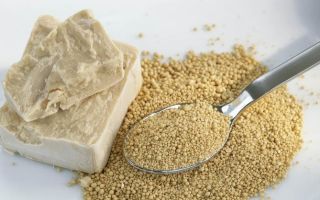Content
- 1 What is yeast and what is it like
- 2 The chemical composition and caloric content of yeast
- 3 Why yeast is good for you
- 4 The benefits and harms of baker's yeast
- 5 The benefits and harms of dry yeast
- 6 Features of nutritional yeast
- 7 Why milk yeast is good for you
- 8 Yeast for weight loss
- 9 How much yeast does the body need per day
- 10 The use of yeast in home cosmetology
- 11 Yeast harm and contraindications
- 12 Conclusion
The benefits and harms of yeast have recently attracted increased interest, accompanied by controversy and even incredible speculation. This substance, from the point of view of biologists, is the living mass of unicellular fungi, which number more than one and a half thousand species. Their beneficial properties are used in various branches of the food industry: beer and brewing, bakery, winemaking, the production of certain dairy products, as well as in cooking, pharmacology, as a therapeutic and prophylactic agent in medicine and animal husbandry.
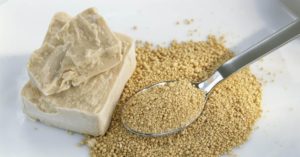
What is yeast and what is it like
These are unicellular chlorophyll-free microorganisms of plant origin that start the processes of fermentation or oxidation of organic compounds, primarily carbohydrates. A person with food consumes several beneficial types of yeast:
- wine: are found on fruits, berries;
- beer: found in malt, hops;
- dairy: in lactic acid products;
- bakery: found on various types of cereals.
The uniqueness and beneficial properties of yeast are that they can live in the absence of air and receive energy from the processes of fermentation and the release of alcohols. Due to the passage of air through the food substrate, they consume oxygen and release carbon dioxide. However, if a large amount of glucose is present in the medium, the fermentation process begins even without air access.
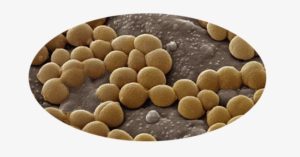
The chemical composition and caloric content of yeast
Since yeast is a single-celled fungus, we can say that it consists of about 65% of proteins, 10% of amino acids, the rest is water, vitamins, micro- and macroelements. There are other beneficial substances in yeast cells:
- polysaccharide;
- nucleic acids;
- glycogen;
- purine and pyrimidine bases;
- the phosphorus compound volutin (complex of ribonucleic acid and polyphosphates);
- vitamins B-group, D;
- palmitic (75%) and stearic (25%) acids.
The calorie content of yeast is about 75 kcal / 100 g of product.
Why yeast is good for you
The beneficial properties of baker's and brewer's yeast have been used by people in medicine since time immemorial. They contain a lot of value for the body: proteins with essential amino acids, carbohydrates and a whole range of enzymes and minerals. That is why this product, which is quite affordable in comparison with dietary supplements, is suitable for the correction of metabolic disorders, problems with immunity, the consequences of stress, as well as for hypovitaminosis.
The benefits of wine yeast for humans lies in their alcohol resistance, fermentation of grape pomace, converting them into high-quality wine. In addition, their beneficial properties are revealed in improving blood circulation processes, strengthening the vascular network, and preventing cardiovascular diseases. Scientists have discovered the relationship between yeast and gastrointestinal microflora, in particular - a beneficial effect on the inflamed intestines.
In addition to the fact that yeast contains micronutrients, they also allow the necessary vitamins (B-groups, C) to be synthesized inside the human body, and also strengthen the immune system by being a catalyst for the most important biochemical processes. Unicellular organisms reduce blood sugar, saturate with many useful substances, including selenium, which has a strong anti-cancer activity.
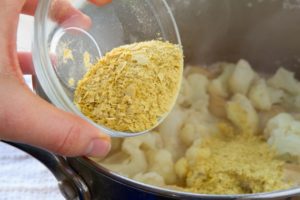
The benefits and harms of baker's yeast
Recently, the benefits of baker's yeast for humans have been questioned. This product is under the scrutiny of nutritionists and gastroenterologists, who are confident that it is extremely harmful. First of all, due to the fact that it does not lose its qualities after baking, it remains in an active state and, probably, becomes the cause of all kinds of diseases.
There is some truth in this, but not one hundred percent. Thermotolerant yeast can withstand temperatures up to +60 oC. But in the oven when baking, it usually rises from +120 and above, and inside the crumb is +95 oC. In such conditions, unicellular organisms do not survive: accordingly, they do not do any harm. Their presence is possible only in unbaked crumb. And then, indeed, yeast can harm a person.
This species is genetically modified, and does not occur in nature: it is not natural (not wild) yeast. Therefore, they can withstand higher temperatures. Such unicellular organisms are relatives of those species that contribute to the development of oncology and harm health. And in excess amounts, genetically modified yeast causes a negative effect (recall) in our body.
The fermentation process is really inherent in human nature and has a beneficial effect on it. But today, its amount significantly exceeds the natural need, which is harmful to humans. We eat bread every day, drink beer and wine made with yeast. Excessive fermentation activity interferes with self-regeneration and recovery of the physical system. At the cellular level, this excess is only harmful to health.
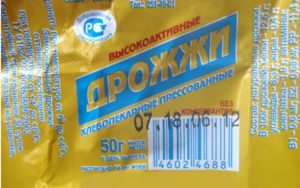
The benefits and harms of dry yeast
Previously, in the kitchen, in the bakery, only pressed sourdough was used. It quickly deteriorated and lost its beneficial properties due to the high water content in the composition. Subsequently, in order to extend the shelf life, they began to dry it. The active state of saccharomycetes passed into a dormant form, and as a result, a product was obtained that, in a sealed package, could not lose its beneficial properties for up to two years.
An additional advantage of dry yeast is that it does not introduce foreign odors into bakery products. They are much easier to handle than pressed ones, so any housewife can do it. In addition, there is a protective layer on granules in dry yeast, which contains glutathione. This substance has beneficial properties when using flour with strong gluten, as it partially neutralizes it.
Features of nutritional yeast
The benefits and harms of nutritional yeast are well known to the healthy eating community. This product has gained popularity among raw foodists and vegetarians, as it is full of useful nutrients. On sale they can be found in the form of flakes, powder, tablets.Nutritional yeast has a cheese flavor, which is why it is often added to casseroles, omelets, and other dishes. They have health benefits:
- remove cholesterol;
- help with constipation;
- improve the intestinal microflora;
- stabilize blood pressure;
- prevent pancreatic cancer.
The drug can cause harm only in case of an allergic reaction or individual intolerance.
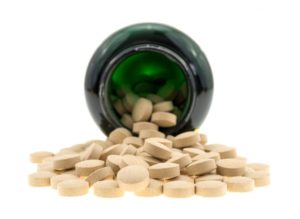
Why milk yeast is good for you
Unlike baker's yeast, this type of microorganism is not dangerous to human health. They contain many useful enzymes that have a positive effect on the condition of the intestinal tract, and with frequent and regular use, they strengthen the immune system, have a beneficial effect on the entire physical system.
Yeast for weight loss
Yeast starter culture can benefit those who want to lose weight. As you know, one of the causes of obesity is the violation of metabolic processes in the body. Yeast helps to eliminate this problem, but physical activity and a balanced diet are also necessary for the beneficial results.
It is necessary to strictly follow the regimen indicated on the package, and also not to get carried away with the drug in pursuit of a slender figure, otherwise the benefit can easily turn into harm. They are consumed in small portions, and high-calorie foods are excluded from the diet.
How much yeast does the body need per day
Yeast is prescribed as a useful remedy for many diseases. These are various infections, furunculosis, diabetes mellitus, skin diseases, gastrointestinal pathologies. In all these cases, the amount of the drug must be established by the attending physician. For example, with low acidity, it is recommended to drink 100 ml of beer sourdough half an hour before meals for a month.
For preventive purposes, the following amount of yeast per day is recommended to enhance protein and vitamin nutrition:
- dry - up to 25 g;
- pressed - up to 100 g;
- yeast paste - up to 50 g;
- drinking - up to 500 g.
The benefits of drinking yeast were widely recognized during the war. With their help, they saved the Soviet people from hunger and disease, helped them survive. Yeast was made from wheat or rye flour: it was a highly nutritious and tasty drink.

The use of yeast in home cosmetology
Knowledge of the health benefits and dangers of yeast is used by people not only in nutrition or medicine, but also in cosmetology: both at home and on an industrial scale. In unicellular organisms, there are especially many beneficial beauty vitamins responsible for skin condition. Ascorbic acid is essential for building collagen, which gives the skin its elasticity and firmness. The beneficial properties of niacin - vitamin PP - are in the regulation of tissue respiration and a beneficial effect on hematopoiesis.
Riboflavin, aka vitamin B2, is actively involved in the formation of hemoglobin. Vitamin B12 promotes the maturation of red blood cells, erythrocytes, which contain hemoglobin. With a lack of the beneficial properties of these two vitamins, the skin becomes pale and begins to peel off. Together, they take care to ensure a beautiful complexion and a healthy blooming look.
For facial skin
Yeast masks are easy to prepare and do not require expensive additives, while they have an abundance of beneficial properties. Several recipes useful for different skin types:
- Normal... Grind 30 g of yeast with 2 tablespoons of boiled milk. Apply to the face, not forgetting the neck. Wash off after 15 minutes;
- Dry... Take 20 g of yeast, a teaspoon of honey, a tablespoon of wheat flour. Grind, adding warm boiled milk to the desired density. The procedure takes 20 minutes. Wash off with warm water;
- Oily, porous... Dilute 20 g of yeast with a small amount of kefir with a minimum percentage of fat - so as to obtain the consistency of thick sour cream. Let dry on the skin, then rinse.
If suddenly the use of a yeast face mask seems questionable, causes a burning sensation or itching, it should be washed off immediately and the irritated skin should be soothed with lotions of chamomile or sage infusion.
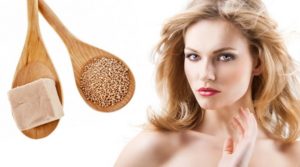
For hair beauty
The benefits of yeast for hair are well known. On their basis, various cosmetic and detergents are made, including at home. For the preparation of masks, you can take both live and dry substrates. To begin with, dissolve in a warm liquid medium (water, milk, kefir, herbal infusion), let it ferment for at least half an hour or an hour. During this time, all active elements will be on alert. There are different useful recipes, depending on the type of hair and the purpose of using the cosmetic product: to accelerate hair growth or simply to strengthen it, heal and nourish it.
For example, for dry hair, a yeast mask with kefir is used, the beneficial properties of which are unique in getting rid of dandruff, moisturizing, nourishing and accelerating growth. To do this, you need to warm up a cup of lactic acid drink, add a tablespoon of dry yeast. Put in a warm place, after an hour apply to hair and scalp. Keep for half an hour and rinse off by rinsing hair with water and vinegar.
Yeast harm and contraindications
Symptoms of yeast intolerance: belching, a feeling of heaviness in the epigastric region, bloating, and sometimes diarrhea. To avoid this, you must first strengthen the digestive tract with the beneficial properties of vegetable juices, and then on an empty stomach in the morning, drink a little beer sourdough. After that, you should eat only when you feel hungry. Failure to comply with these conditions results in intolerance to the product.
Contraindications for taking yeast: kidney disease, gout, some other cases. If the kidneys are normal, then yeast, on the contrary, has beneficial properties and maintains them. Beer starter also triggers the release of estrogen in the human body. In both women and men, large amounts of estrogen can cause negative biochemical reactions.
To learn more about the beneficial properties, dangers and contraindications for taking yeast, see the video:

Conclusion
The benefits and harms of yeast largely depend on the amount of intake of a product made with their participation. If you overuse beer, wine or baked goods, it is possible to get side effects from excessive fermentation in the body.

